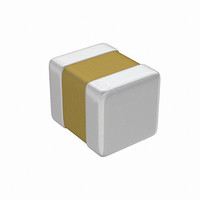05045C103MA71A AVX Corporation, 05045C103MA71A Datasheet - Page 4

05045C103MA71A
Manufacturer Part Number
05045C103MA71A
Description
CAP CER 10000PF 50V X7R 0504
Manufacturer
AVX Corporation
Datasheet
1.05041A1R0DAT1A.pdf
(48 pages)
Specifications of 05045C103MA71A
Capacitance
10000pF
Voltage - Rated
50V
Tolerance
±20%
Temperature Coefficient
X7R
Mounting Type
Surface Mount, MLCC
Operating Temperature
-55°C ~ 125°C
Features
Low ESL
Applications
General Purpose
Package / Case
0504 (1210 Metric)
Size / Dimension
0.050" L x 0.040" W (1.27mm x 1.02mm)
Thickness
1.02mm Max
Lead Free Status / RoHS Status
Lead free / RoHS Compliant
Ratings
-
Lead Spacing
-
Effects of Voltage – Variations in voltage have little affect
on Class 1 dielectric but does effect the capacitance and
dissipation factor of Class 2 dielectrics. The application of
DC voltage reduces both the capacitance and dissipation
factor while the application of an AC voltage within a rea-
sonable range tends to increase both capacitance and dis-
sipation factor readings. If a high enough AC voltage is
applied, eventually it will reduce capacitance just as a DC
voltage will. Figure 2 shows the effects of AC voltage.
Figure 2
Capacitor specifications specify the AC voltage at which to
measure (normally 0.5 or 1 VAC) and application of the
wrong voltage can cause spurious readings. Figure 3 gives
the voltage coefficient of dissipation factor for various AC
voltages at 1 kilohertz. Applications of different frequencies
will affect the percentage changes versus voltages.
Figure 3
The effect of the application of DC voltage is shown in
Figure 4. The voltage coefficient is more pronounced for
higher K dielectrics. These figures are shown for room tem-
perature conditions. The combination characteristic known
as voltage temperature limits which shows the effects of
rated voltage over the operating temperature range is
shown in Figure 5 for the military BX characteristic.
General Description
2
10.0
50
40
30
20
10
8.0
6.0
4.0
2.0
0
0
Curve 1 - 100 VDC Rated Capacitor
Curve 2 - 50 VDC Rated Capacitor
Curve 3 - 25 VDC Rated Capacitor
D.F. vs. A.C. Measurement Volts
Cap. Change vs. A.C. Volts
.5
AC Measurement Volts at 1.0 KHz
12.5
Volts AC at 1.0 KHz
AVX X7R T.C.
1.0
AVX X7R T.C.
25
1.5
2.0
37.5
2.5
Curve 3
Curve 1
Curve 2
50
Effects of Time – Class 2 ceramic capacitors change
capacitance and dissipation factor with time as well as tem-
perature, voltage and frequency. This change with time is
known as aging. Aging is caused by a gradual re-alignment
of the crystalline structure of the ceramic and produces an
exponential loss in capacitance and decrease in dissipation
factor versus time. A typical curve of aging rate for semi-
stable ceramics is shown in Figure 6.
If a Class 2 ceramic capacitor that has been sitting on the
shelf for a period of time, is heated above its curie point,
(125°C for 4 hours or 150°C for
will de-age and return to its initial capacitance and dissipa-
tion factor readings. Because the capacitance changes
rapidly, immediately after de-aging, the basic capacitance
measurements are normally referred to a time period some-
time after the de-aging process. Various manufacturers use
different time bases but the most popular one is one day or
twenty-four hours after “last heat.” Change in the aging
curve can be caused by the application of voltage and other
stresses. The possible changes in capacitance due to de-
aging by heating the unit explain why capacitance changes
are allowed after test, such as temperature cycling, mois-
ture resistance, etc., in MIL specs. The application of high
voltages such as dielectric withstanding voltages also tends
Figure 4
Figure 5
+10
+20
-2.5
-7.5
-10
-20
-30
-10
2.5
-5
0
0
-55 -35
Typical Cap. Change vs. Temperature
Cap. Change vs. D.C. Volts
Temperature Degrees Centigrade
-15
25%
AVX X7R T.C.
AVX X7R T.C.
Percent Rated Volts
+5
+25 +45 +65 +85 +105 +125
50%
OVDC
RVDC
1
⁄
2
hour will suffice) the part
75%
100%











